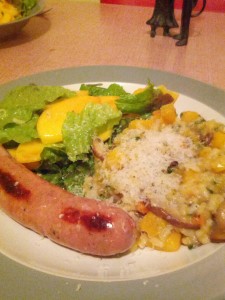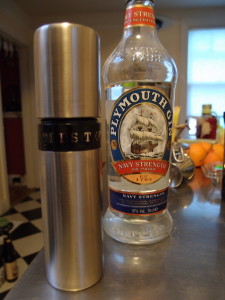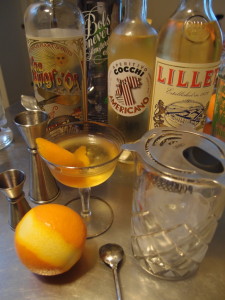I’m currently reading, “Cosmopolitan: A Bartender’s Life,” by Toby Cecchini.
While a lot of the passages are entertaining and interesting, the following regarding his father’s gin & tonic ritual was one of the most vivid.
“One of my fondest running memories I have of growing up is arrival in his kitchen after the long, stuffy Greyhound bus ride from Madison and sitting to chat with him while he prepared drinks. He would take down a tall crystal pitcher and pour it almost a quarter full of gin. For years we had an ongoing polemic about which gin to use. He used to claim all gin was simply grain neutral spirits spiked with juniper and that it made no difference which one you used. One visit, then, I brought up a bottle of Tanqueray and won that argument handily. Taking fat limes at room temperature, he would need them in the ball of his hand against the cutting board, setting the intoxicating aroma tumbling through the room. This brings the citrus oil to the surface, he explained, and allows the gin to act as a solvent, removing and incorporating it into the drink. He He would cut them in half, juice them, and set the juice aside. He would slice the rinds into thin strips, which he then dumped into the gin and pummeled a bit with a pestle. The juice was added to cause further extraction. At this point he would invariably swirl the pitcher under my nose and declare solemnly, ‘You could wear this as cologne!’
“While that marriage was left to macerate for a few minutes, he would then take large ice cubes and, palming them lightly, thwack them expertly with the back of a heavy spoon, just once, whereupon they would obediently crumble into perfect shards, which he would scatter into the pitcher until it was half full or so with aromatic lime granita. I always marveled at the elan with which he pulled off that simple action; my efforts at duplicating this maneuver always end with me bludgeoning the recalcitrant glacier mercilessly as chips fly helter skelter.
“He would remove the tonic from its chilling and pour it gingerly, on a slant, down the side of the pitcher, stirring it cursorily with a tall glass want, just so the gin, which rises to the top, gets distributed; you don’t want to jostle that life-giving fizz out of it. We would take glasses from the freezer, garnished with fresh lime rounds for aesthetics, and carry the whole works like an Easter processional on a try out to the front porch. In the late-norther twilight with my first drink as a young man, chatting with my dad, I could feel the tie to civilization, the history in this lovely laying down of one’s burdens at the day’s close.”
Who could read that and NOT desire a Gin & Tonic?
The Gin & Tonic is an interesting bird. You’ll never really find a recipe or method for making one in a cocktail book. Like the Pimm’s Cup, I guess it is just too simple to be included with more complicated cocktails.
On the other hand…
When we were in Spain a few years ago, we were trying to get in to the Dry Martini Bar. Unfortunately, they had a private event, so we went across the Street to Peter’s Tavern and ordered Gin & Tonics. The ritual with which the bartender prepared 4 Gin & Tonics rivaled the Sazerac in its complexity. I was totally blown away by the grace and elegance with which he prepared the seemingly ‘simple’ drink. First the frilled beverage napkins were placed upon the bar in front of us. Then the bartender pulled out chilled glasses and hand selected cubes with tongs to fill each glass. Placing the glasses in front of him, he first poured the gin. A lot of Gin. Then he gently poured the tonic (Schweppe’s Indian) down the side. He stirred each gently, then, using tongs added the straws and lemon garnish. Finally he placed each glass in front of us to enjoy.

So let’s try and translate Mr Cecchini, the younger’s, rather large block of text into a recipe.
First, there are four components in a Gin and Tonic.
Gin: Other types of Gin are interesting, but when making a Gin & Tonic, I’m afraid I have to insist on a stiff, Juniper forward, traditional London Dry Gin, made in England. In the US, your choices of traditional London Dry Gin made in England are basically Beefeater, Plymouth, and Tanqueray. As we can see above, Mr Cecchini, the younger, favors Tanqueray, and I do not disagree. (If you must use an American Gin, about the only two, (I’ve tried,) which hew fairly closely to the London Dry blueprint are Anchor’s Junipero and Death’s Door Gin.) Regarding the amount of Gin, you will often find people rather overpour the Gin & Tonic. I prefer to stick to 1 1/2 oz per person and a highball glass on the smaller size. Otherwise, the drink waters down before you finish.
Tonic: The classic Tonic is Schweppes Indian Tonic, but it is rather hard to come by in the US and also tends to be priced at a premium. As a rule, when possible, I avoid anything with High Fructose Corn Syrup or Agave Nectar, so this leaves me with Fever Tree or Stirrings, which are also not cheap. I personally prefer Fever Tree, but your mileage may vary.
Ice: As Mr Cecchini, senior, cracked his ice, so shall we. I make cubes in my Tovolo King Cube Ice trays and then crack them into shards and cubes with a lovely japanese ice pick, purchased from Cocktail Kingdom.
Citrus Garnish: In some parts of Europe, you are far more likely to find your Gin & Tonic garnished with lemon than the lime more common in America. I prefer lime, I guess because it is what I am used to, though lemon is ok in a pinch. Mr Cecchini, senior’s, recipe is the first I’ve seen where the juice is quite literally separated from the skins in the drink. Interesting, I’ll give it a try. Also, do note you will get more juice out of a lime if it is at room temperature.

Gin & Tonic for Two a la pere Cecchini
3 oz London Dry Gin
1 Lime
about 7 oz Tonic (or one 200ml bottle)
Ice
Lime Wheel for Garnish (optional)
METHOD: Peel limes longitudinally (from top to bottom). Squeeze peels into a mixing glass or pitcher and drop in. Add Gin to mixing glass. Juice lime and add to mixing glass, should be between 1/2 to 3/4 oz lime juice. If your limes are sad and dry, you may need more than 1. Crack ice and add to mixing glass. Ice two collins glasses, no more than 12 oz. Stir gin and lime juice briefly and strain into two glasses. Pour tonic down the side of the glasses to nearly fill and stir gently. Garnish with lime wheels and serve immediately.
To be honest, one of my favorite things about this recipe is that it is for two. Individual cocktails are cool, but making pitchers of cocktails is even better, especially for loved ones and friends. And this is quite delicious, almost more like a Gin Rickey with Tonic than what I usually associate with GNT. However, I’m not going to be a stickler when the results are this appealing.

Especially when served as an aperitif before a classic Flannestad fall dinner for two like: Arborio Rice with Butternut Squash and Mushrooms. Grilled Sausages. Red Romaine salad with Fuyu Persimmon in a white wine, sage, and scallion dressing.

Bonus picture of Monty the Dog at Fort Funston! Ball!








